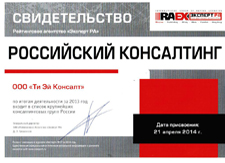НАША МИССИЯ
Мы содействуем становлению и развитию финансового сектора в странах Восточной Европы и СНГ, помогаем финансовым институтам добиться успеха, стабильности и процветания.
Контакты:
- — Россия
- — Великобритания
- — Беларусь
- — Украина
Целесообразность каждого из них необходимо оценивать сугубо с учетом поставленных задач, текущего состояния действующего бизнес-процесса, уровня квалификации персонала, уровня занятости основных специалистов и т.д. Положительные примеры реализации проекта есть как по любой из перечисленных форм сотрудничества с консультационными компаниями,
Title
As we all know, any business activity bears certain risks, some less, some more. Risks of financial institutions are the most frightening. The risks of losing money, production facilities or skilled workers have significant impact on the forms and methods of management.
Thus, financial risks are the risk associated with a certain probability of loss of funds. Financial risks appeared along with money and the commodity-money relations and a new profession appeared fairly recently - the Risk Manager.
Risk Manager at a non-bank financial institution (NBFI) has to make decisions based on the following criteria of risk sharing:
- Risks associated with commercial lending;
- Risks associated with capital turnover.
Risks associated with commercial lending. This type of risks implies possibility of discrepancy between the time of receipt of goods or services with the terms of loan repayment. In other words, the risk when the loan is not repaid on time and the loan becomes problem.
Risks associated with capital turnover. Risks of this nature are characterized by the probability of lack of funds during the regular turnover of goods or services. Insurance for this type of risks often appear to be open lines of credit.
In managing risks the risk manager should objectively assess the circumstances affecting the degree of risk as well as to adhere to the following scheme of action:
1. Identify the goals of the organization;
2. Find out what risks exist in achieving the goals;
3. Evaluate possible negative effects, i.e. risks;
4. Choose how to manage possible risks;
5. Directly manage the risks;
6. Summarize the work done.
With use of the above scheme of action minimization of consequences from the occurrence of risk circumstances becomes most effective.
If you are interested in risk management at a non-bank financial institution, please call +7 (812) 498 65 80.
TA Consult experts will answer your questions.
NEWS
7 September 2022
The programme to strengthen Azerbaijani financial institutions, funded by the European Bank of Reconstruction and Development (EBRD), the European Union and Türkiye, successfully completed.
more »15 January 2020
TA Consult starts implementation of Uzbekistan: Food Safety Review Project
more »4 January 2020
TA Consult starts implementation of Diagnostics Project with Moldova Agroindbank (MAIB)
more »









